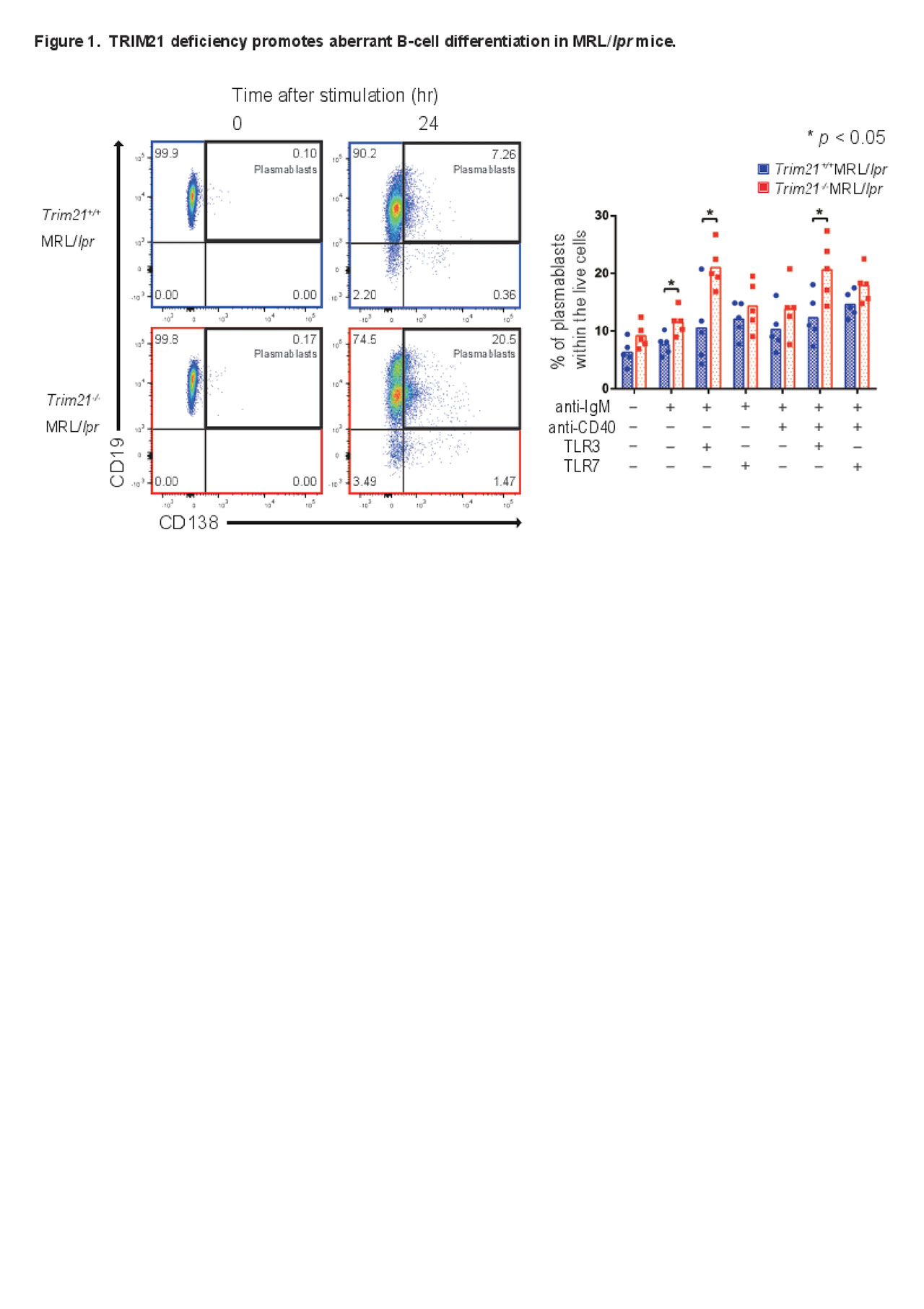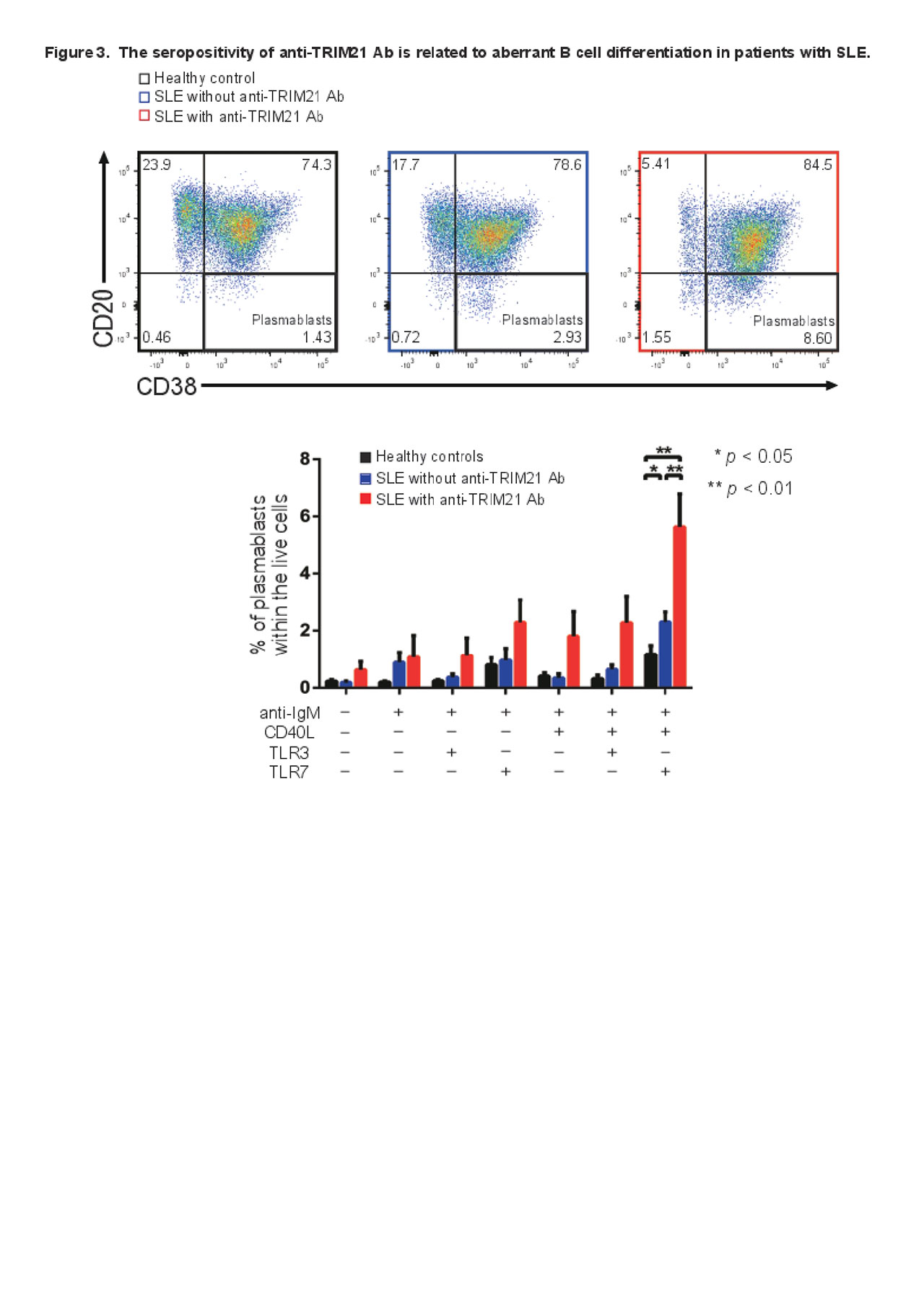Session Information
Date: Sunday, November 10, 2019
Title: SLE – Animal Models Poster
Session Type: Poster Session (Sunday)
Session Time: 9:00AM-11:00AM
Background/Purpose: TRIM21 is a member of the tripartite motif family proteins and is one of the autoantigens which react with anti-SS-A antibody (Ab) present in sera of patients with systemic lupus erythematosus (SLE) and Sjögren’s syndrome. Although TRIM21 has been thought to play a role in B-cell proliferation and apoptosis, the role of TRIM21 in SLE pathogenesis is still unknown. Previous studies have shown the data strongly suggesting that TRIM21 can act as a suppressor for autoimmune and inflammatory response and that its dysfunction can cause the pathological state of SLE. Here we examined the pathological role of TRIM21 in SLE using Trim21-deficient lupus model mice and B cells from SLE patients.
Methods: Trim21-deficient MRL/lpr mice were generated by backcrossing Trim21-deficient C57BL/6 mice to MRL/lpr mice. Urine albumin/creatinine ratio was measured as the urine protein level. Anti-dsDNA and anti-TRIM21 Abs were measured by enzyme-linked immunosorbent assay. CD43-negative resting B cells were isolated from mouse spleens or peripheral blood of SLE patients by magnetic-activated cell sorting and stimulated with several Toll-like receptor (TLR) ligands. The abilities to differentiate into plasmablasts and to product Ab were examined by flow cytometry and bead-based immunoassay, respectively.
Results: The levels of urine protein and serum anti-dsDNA Ab at 28 weeks of age were significantly higher in Trim21-deficient MRL/lpr mice as compared to wild-type MRL/lpr mice (p = 0.029 and 0.003, respectively). When we stimulated resting B cells from these mice with TLR ligands for 24 hours, B cells from Trim21-deficient MRL/lpr mice showed significantly higher abilities to differentiate into plasmablasts (Figure 1) and to produce Ab (Figure 2) as compared to wild-type MRL/lpr mice. Due to the reduction of TRIM21-mediated ubiquitylation, IRF5 protein expression was increased in Trim21-deficient MRL/lpr mice (p = 0.021), which correlated with increased plasmablasts generation. B cells from SLE patients with anti-TRIM21 Ab seropositivity also indicated significantly higher ability to differentiate into plasmablasts and to produce Ab as compared with SLE patients without anti-TRIM21 Ab seropositivity or healthy controls (Figure 3).
Conclusion: TRIM21 dysfunction promotes aberrant B-cell differentiation and Ab production in SLE. Anti- TRIM21 Ab may be related to the TRIM21 dysfunction in human SLE pathogenesis. These findings suggest that TRIM21 and anti-TRIM21 Ab can be promising targets for SLE treatment.
To cite this abstract in AMA style:
Kunishita Y, Yoshimi R, Kamiyama R, Kishimoto D, Yoshida K, Hashimoto E, Sugiyama Y, Komiya T, Sakurai N, Kirino Y, Nakajima H. Dysfunction of TRIM21 Promotes Aberrant Plasmablast Differentiation in Systemic Lupus Erythematosus Due to the Reduction of TRIM21-mediated Ubiquitylation of IRF5 [abstract]. Arthritis Rheumatol. 2019; 71 (suppl 10). https://acrabstracts.org/abstract/dysfunction-of-trim21-promotes-aberrant-plasmablast-differentiation-in-systemic-lupus-erythematosus-due-to-the-reduction-of-trim21-mediated-ubiquitylation-of-irf5/. Accessed .« Back to 2019 ACR/ARP Annual Meeting
ACR Meeting Abstracts - https://acrabstracts.org/abstract/dysfunction-of-trim21-promotes-aberrant-plasmablast-differentiation-in-systemic-lupus-erythematosus-due-to-the-reduction-of-trim21-mediated-ubiquitylation-of-irf5/



